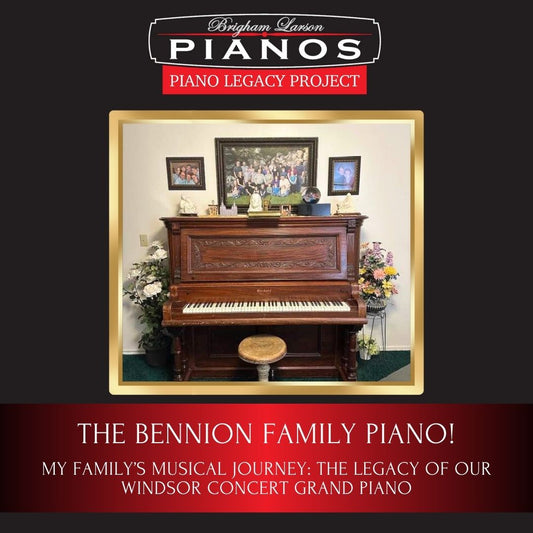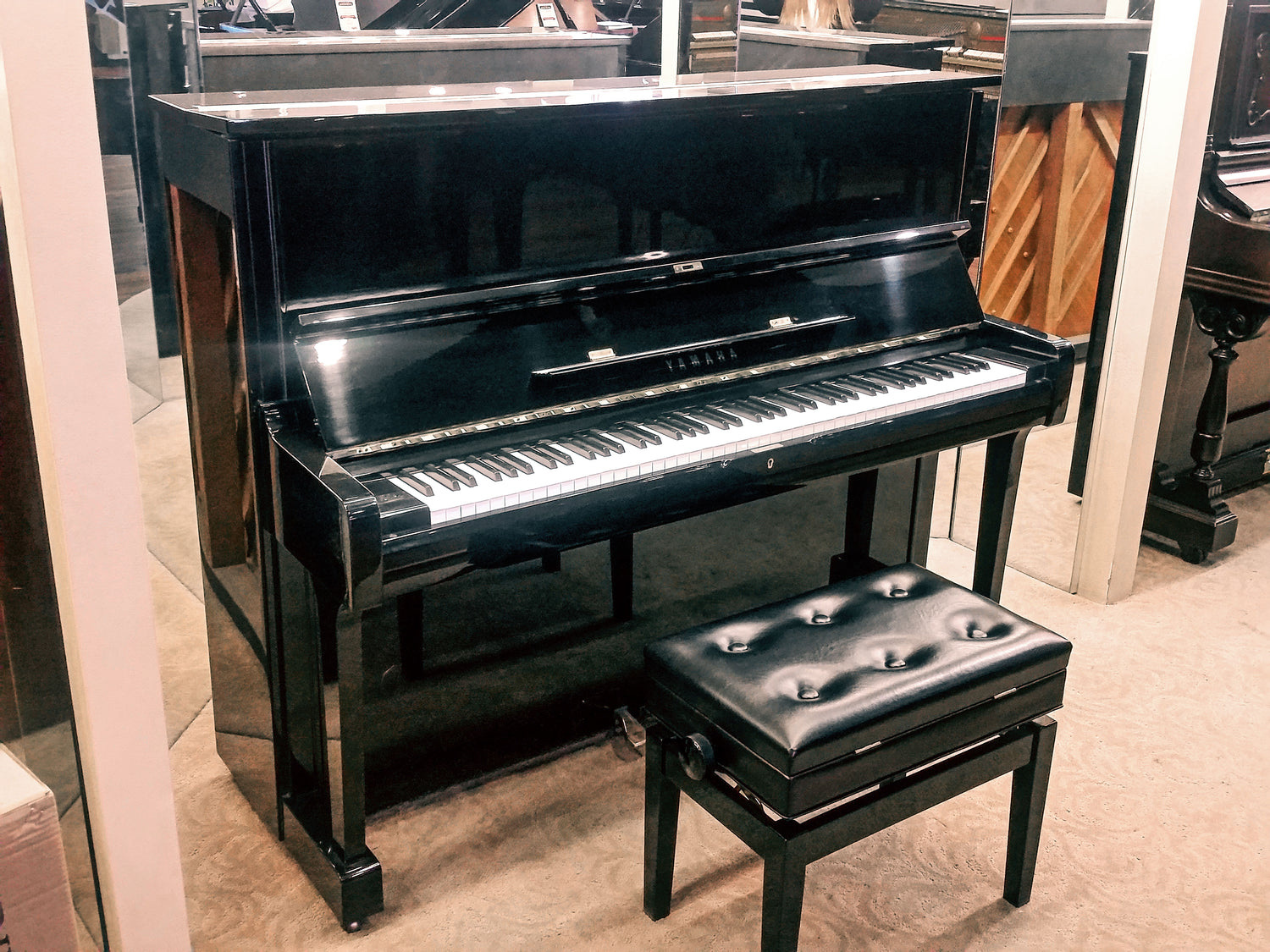
The Anderson Family Piano!
Brigham Larson PianosShare
I started playing the piano in kindergarten and took lessons through high school. Music has always been a big part of my life. I live in Millcreek with my husband and four daughters. I'm a part time artist (oil and acrylic painter) and a full-time mom.
The spaces and objects we use daily are vessels for our lived experiences. The if-these-walls-could-talk special structures, and the special things that are housed there, are perhaps the most constant witnesses to life. The Wellington piano I got from my parents (who got it from my grandparents) has been a witness to my growing up, to my coming into my role as a mother, and has always been a ready vessel to which I have poured my heart.
My grandparents bought an old, upright Wellington piano at a garage sale in the 1970s for $300. I remember Grandma telling me that Grandpa had thought he would refinish it, but only got as far as sanding and staining the bit of trim above the upper panel before moving on to more pressing projects. It was the instrument my aunt and uncles played in their home in Provo. My uncle recalls “I took lessons [on this piano]. I went to a teacher named Barbara Taylor. A girl, Amy, would linger after her lesson so she could see me and flirt. It made me uncomfortable so I stopped taking piano lessons. I remember saying ‘Mom, I know I’m going to regret this later in life, but I’m quitting piano.’” Regardless of his not sticking with piano, my grandparent’s home has always been a place of music and performing.
Years later, the piano made its way to my childhood home in the Grandview neighborhood in Provo. It’s there that my siblings and I began taking lessons and would spend time practicing in the basement. The piano was often a recipient of frustration as practicing always means making many mistakes. I remember my mom ironing behind me as I practiced one day, making the same mistake each time I went through my songs. She said, “Practicing in mistakes is like ironing in wrinkles. It takes extra practice to undo a mistake you’ve ironed in, just like it takes steam or spraying the wrinkle to smooth it out.” A vivid lesson as I watched her puff steam out of the iron and it taught me to slow down and try to get things right from the start. (It’s an analogy I have since used with my own piano-practicing daughters.)
As a child, opening up and seeing the mechanics of this piano taught me how pianos work. We loved opening the upper panel and playing our songs--perhaps as many notes as we could at once or a super fast chromatic scale. I began to understand as a young child that the force of the hammer striking the string determines the dynamics. I saw that low notes had big strings and the high notes had small strings. I remember playing with the pedals and watching the dampers, suspended above the strings, allowing them to ring. Engaging this patient playmate-of-an-instrument, I began to understand principles of music (and physics!). It was not only a receptacle for my curiosity, but a springboard that made me want to discover more.
As my family of origin grew, four kids were soon taking piano lessons at the same time. It was tight. My parents made the financially-stretching purchase of a baby grand. This showed us how serious they were about music and also another practicing station. This shiny new piano began to be the sought after practice companion, and the Wellington upright was relegated to the dimly lit office across the entryway. Practicing on the big piano led to daydreaming about being a musician. I began, shyly, to tinker with writing my own music. As a teenager, writing piano music became a welcome way to work through the growing pains of adolescence and gave me a productive outlet to process my feelings. The office had a door on it, and so this solitary, sturdy piano-companion was my afternoon partner in private creation. I would type out lyrics and chords on the computer, print them, swivel around, and try out my compositions behind a door that blocked out self-consciousness.
By the time I was twenty, I was married. My mom told my sister and I that whomever was settled in a home first, could have the old piano as they were ready to make space in the office and clean out the clutter of raising kids. I felt a twinge of jealousy when my early married years, full of moves across the country and even one across the ocean and back, meant that my sister was the first to buy a house, and therefore, provide a home to the piano. I remember visiting her and seeing half a dozen potted plants living atop the dusty piano. I was so worried about the water ruining this piece of my childhood memories! Luckily for me, they couldn’t keep it for long. Their next move coincided with our purchase of our first home and we became the new stewards of the Wellington piano.
Our postage stamp of a home was built during WWII, a time when resources were scarce and the marriage of modern conveniences and modesty were marks of patriotism. As a result, our house didn’t have a fireplace, one of the features I was most looking forward to. (I needlepointed our Christmas stockings and was so looking forward to seeing them hung in a row on the mantle.) The piano became a willing stand-in as the hearth of our home. For a few weeks it was one of a few items of furniture in what our 3 year old called, “the ballroom.” I would play and she would dance around the room. That December, I hung 4 stockings on the piano, flanking either side of some favorite Christmas music. The piano became the heart of that room. We decorated it for holidays, displayed family photos on top and before I could believe it, began teaching our daughters the piano on its now-chipped keys.
There were moments that felt like falling through time as I listened to my kindergartener playing the same songs from the Bastien piano books that I played decades before on the same piano. This piano has been a witness to a growing family and all the growing pains and the stretching joyful times that family life brings. We have hosted talent shows for birthdays, gathered around to sing Christmas carols, jammed to pop songs, frustratingly learned new music, and tearfully revisited old tunes.
This piano has been a receptacle of so much joy and sorrow. I have lined up chocolate chips on its edge, rewarding a reluctant practicer with each drill of a tricky measure. I have played comforting hymns in the wake of heartbreak. I have laughed until I cried as we watched a friend play the piano upside down with her toes during a birthday talent show. I have sat on its bench and had hard conversations. I have felt my heart soar in joy as my girls have grown as musicians. I played it during the 2020 pandemic holiday season, singing “Someday soon we all will be together, if the fates allow/ Until then we’ll have to muddle through somehow!” and feeling a flood of yearning.
This piano has been like a steady friend that I walk past several times a day, bearing witness to all the growth, the past, and the future. I can’t wait to see it continue to be a willing vessel for our love and growth as it gains a new life through restoration. Talent shows, piano recitals, Christmas carols, sonatas, pop song jams and silly duets—it would be beautiful to allow generations to come experience it the way I have.
- YEAR 1800-1900
- MAKE Wellington Cable Piano Company of Chicago
- SERIAL NUMBER 155111
- FINISH some wood, some black, but not shiny black
- RENTAL PRICE $NaN
- FINANCE PRICE $NaN
- CATEGORY CONTESTANT











